By continuing to browser our site and use the services you agree to our use of cookies, Privacy Policy and Terms of Use. You can change your cookie settings through your browser.
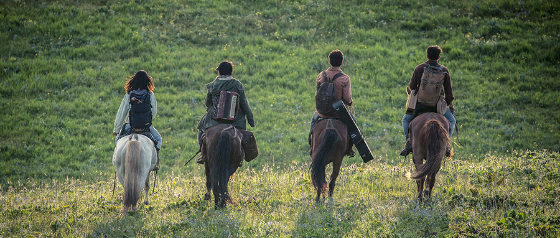
Stills from The Wings of Songs show the protagonists riding across a prairie in Xinjiang Uygur autonomous region. [Photo provided to China Daily]
Stories center on quest to collect folk songs, and highlight the unity of the various ethnic groups in the picturesque autonomous region, Wang Ru reports.
Under the crystal-clear blue sky stretches a vast prairie, where people from different ethnic groups sing and dance affectionately together. Behind them are majestic snowcapped mountains. Everything looks fresh and happy.
The scene comes from Chinese musical film The Wings of Songs, which hit screens across China on March 28.
Made by the Publicity Department of Northwest China's Xinjiang Uygur autonomous region and the Tianshan Film Studio, the film tells the story of three young people who embark on a journey across Xinjiang to collect folk songs and pursue their dream of becoming musicians
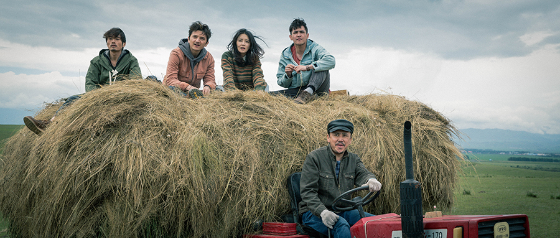
Stills from The Wings of Songs show the protagonists taking a ride on a hay cart. [Photo provided to China Daily]
"We want to show an example of China's musical films, and portray modern Xinjiang which is steady, harmonious and beautiful," says Gao Huanggang, general director of the film and president of Tianshan Film Studio.
According to Gao, two storylines run through the production. One follows the three young people, including Jiang Han, and their pursuit of an artistic dream, the other focuses on Jiang's teacher, Li Mingliang, who works as a volunteer village educator over a period of decades.
"In the film, the two stories overlap, showing the spirit of Li, and others of his generation, who devoted their lives to making a contribution to Xinjiang, and the inheritance of that spirit by Li's students," says Gao.
The film also highlights the beautiful scenery of Xinjiang.
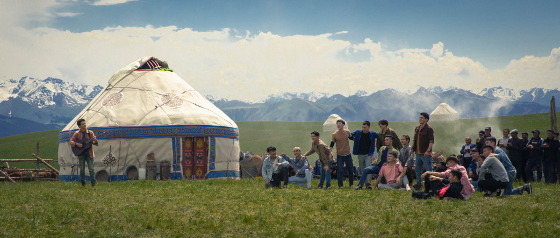
Stills from The Wings of Songs show the protagonists singing and dancing with locals in Ili Kazak autonomous prefecture. [Photo provided to China Daily]
"Starting in 2019, over the course of two-and-a-half months, we traveled to five prefectures, including Tacheng, Kezilesu Kirgiz and Ili Kazak, to make the film, recording beautiful scenery, such as the snowcapped peaks, deserts and grasslands," says director Abdukerim Abliz.
As a musical film, the production features eight songs, four performances of which combine singing and dancing, which demonstrate the folk music of eight ethnic groups in Xinjiang.
According to Gao, China makes few domestic musical films due to the high cost of production and low return on investment, but they wanted to make one inspired by the music and culture of dance in Xinjiang.
"Xinjiang has many ethnic groups, and their diversified culture of music and dance show the features of each one. We want to show them to the audience," he says.
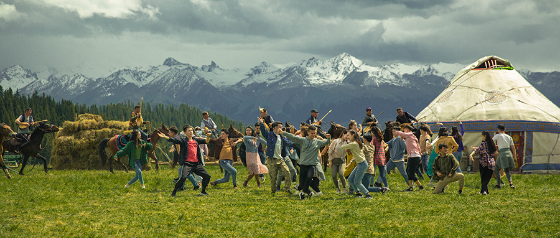
Stills from The Wings of Songsshow the protagonists singing and dancing with locals in Ili Kazak autonomous prefecture. [Photo provided to China Daily]
"For example, nearly everyone from the Uygur ethnic group is good at singing and dancing," he adds. "The way the women dance shows their elegant and unfolding posture, and the way the men dance is more robust and energetic.
"Moreover, Kazak folk songs have a high pitch and sound melodious, especially when accompanied by dongbula, a traditional musical instrument of the ethnic group."
Crew members considered how to integrate the music with the plot. "If we focused only on the film's story, then the music would be ignored, but if we paid too much attention to the expression of the music, the story would not be attractive enough," recalls Li Mushi, the film's scriptwriter.
As a result, Li used music to tell stories, making the music part of the plot.
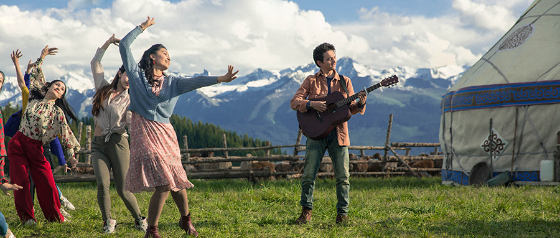
Stills from The Wings of Songsshow the protagonists singing and dancing with locals in Ili Kazak autonomous prefecture. [Photo provided to China Daily]
"For example, nearly everyone from the Uygur ethnic group is good at singing and dancing," he adds. "The way the women dance shows their elegant and unfolding posture, and the way the men dance is more robust and energetic.
"Moreover, Kazak folk songs have a high pitch and sound melodious, especially when accompanied by dongbula, a traditional musical instrument of the ethnic group."
Crew members considered how to integrate the music with the plot. "If we focused only on the film's story, then the music would be ignored, but if we paid too much attention to the expression of the music, the story would not be attractive enough," recalls Li Mushi, the film's scriptwriter.
As a result, Li used music to tell stories, making the music part of the plot.
FTP Expert Talks | Xiaodong Lee, Vice President of the Internet Society of China and Founder of the Fuxi Institution: Hainan is the "Nebula" of New Digital Youth
09:47, 12-September-2025Hainan Issues Offshore RMB Bonds in HK for 4th Consecutive Year
09:46, 12-September-20252025 Hainan FTP International Students Content Creation Project
02:28, 12-September-2025What Makes "Hainan Travel" So Appealing?
09:38, 11-September-2025100 Days to Go: What's Next for Hainan-Hong Kong Cooperation?
09:38, 11-September-2025Expert Talks Ep. 4: The Future of the FTP's Digital Economy
09:35, 11-September-2025By continuing to browser our site and use the services you agree to our use of cookies, Privacy Policy and Terms of Use. You can change your cookie settings through your browser.





